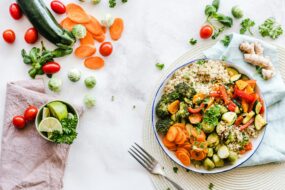
In the hustle and bustle of modern life, healthy eating often takes a backseat to convenience. Between juggling work, family, social commitments, and personal goals, it’s easy to fall into the trap of fast food, takeout, and snack-driven meals. But here’s the good news: with a little planning, you can reclaim your health and time. Enter meal prep—the smart, efficient way to nourish your body even when life gets chaotic.
What Is Meal Prep?
Meal prep refers to the process of planning, preparing, and packaging meals or meal components ahead of time. This can mean cooking full meals for the week, chopping veggies in advance, or even just making a few healthy snacks to have on hand. The idea is to reduce the daily stress of deciding what to eat and to make nutritious food more accessible and less time-consuming.
Why Meal Prep Works
Meal prepping isn’t just a trend—it’s a game-changer. Here’s why:
- Saves Time: Cook once, eat multiple times. You’ll spend less time in the kitchen each day.
- Supports Healthy Choices: Prepped meals help you avoid impulse eating or reaching for unhealthy options.
- Saves Money: You’ll cut down on expensive takeout or food waste.
- Reduces Stress: No more last-minute decisions or grocery store runs.
- Improves Portion Control: You’ll be more aware of what and how much you’re eating.
Let’s dive into how to make meal prepping fit seamlessly into your busy lifestyle.
Step 1: Set Your Meal Prep Goals
Before diving in, identify your “why.” Are you trying to:
- Eat cleaner?
- Lose weight?
- Save money?
- Support fitness goals?
- Free up your weeknights?
Knowing your goals will help guide your choices and keep you motivated. It’ll also help determine what types of meals to prepare and how much time to devote to the process.
Step 2: Choose Your Meal Prep Style
Meal prep isn’t one-size-fits-all. Here are a few common approaches:
- Full Meal Prep: Cook entire meals in advance (e.g., lunch and dinner for 4-5 days).
- Batch Cooking: Cook large quantities of specific ingredients (like rice, chicken, or roasted veggies) and mix and match throughout the week.
- Ingredient Prep: Chop veggies, marinate proteins, or cook grains in advance so you can throw together meals quickly.
- Grab-and-Go Prep: Prepare snacks, smoothies, or breakfast items that can be quickly eaten on the run.
Pick one or combine styles depending on your lifestyle and goals.
Step 3: Plan Your Menu
Keep it simple, especially if you’re just starting. Choose 2-3 breakfast options, 2-3 lunch/dinner recipes, and a few snacks. Repeat meals during the week to make shopping and prepping easier.
Tips for Planning:
- Balance is key: Each meal should ideally include a source of protein, healthy fat, fiber, and complex carbohydrates.
- Make it realistic: Don’t plan seven different meals if you only have time to prep two.
- Incorporate variety: Rotate sauces, spices, and sides to avoid flavor fatigue.
Example Weekly Plan:
- Breakfast: Overnight oats with fruit and nuts; egg muffins with spinach and tomatoes
- Lunch: Quinoa bowls with roasted vegetables and hummus; grilled chicken wraps
- Dinner: Turkey meatballs with zucchini noodles; tofu stir-fry with brown rice
- Snacks: Hummus with veggie sticks; Greek yogurt; trail mix; energy bites
Step 4: Make a Grocery List
Take your meal plan and break it into a shopping list organized by category (produce, protein, pantry, frozen, dairy, etc.). This keeps your grocery trip efficient and ensures you don’t forget anything.
Grocery Tips:
- Buy in bulk when possible (e.g., rice, lentils, oats).
- Choose frozen fruits and vegetables for convenience and longevity.
- Opt for multi-purpose ingredients (e.g., spinach can go in smoothies, eggs, and stir-fry).
Step 5: Set Aside Prep Time
Block off 1-2 hours once or twice a week to do your prepping. Many people prep on Sundays and Wednesdays. Choose a time when you won’t feel rushed and can enjoy the process—throw on a playlist or podcast to make it more fun.
Kitchen Hacks to Save Time:
- Use an air fryer, Instant Pot, or slow cooker to multitask.
- Roast multiple trays of vegetables at once.
- Cook grains in bulk and freeze extras.
- Wash and chop all produce at once.
Step 6: Invest in Good Containers
The right containers make a big difference. Look for:
- Glass containers: Durable, microwave/oven safe, and eco-friendly.
- Compartmentalized containers: Great for keeping different components separate.
- Portable snack containers: Perfect for on-the-go munching.
Label your containers with the prep date, especially if you’re prepping for several days in advance.
Step 7: Store Smart
How you store your food impacts freshness and safety.
- Keep prepped meals refrigerated for up to 4 days.
- Freeze meals or components if prepping for longer than that.
- Store sauces and dressings separately to avoid sogginess.
- Label frozen items with name and date.
Fridge Organization Tip:
Dedicate zones in your fridge to prepped items so they’re easy to grab and go. For example, top shelf for breakfasts, middle for lunches, bottom for dinners, and a side drawer for snacks.
Step 8: Mix and Match
Avoid boredom by using versatile base ingredients you can remix throughout the week.
- Grains: Use rice, quinoa, or couscous as a base for salads, stir-fries, and bowls.
- Proteins: Season chicken in different ways for tacos, wraps, or bowls.
- Veggies: Roast a big batch and toss them into eggs, pasta, or grain bowls.
Use condiments, dressings, herbs, and spices to add variety without extra work.
Bonus: No-Cook and Low-Cook Options
Pressed for time or don’t love cooking? Try these easy prep options:
- Mason jar salads: Layer your ingredients for easy, fresh salads.
- Overnight oats or chia pudding: Prep several jars at once.
- Rotisserie chicken: A shortcut protein that pairs well with any grain or veggie.
- Snack boxes: Create mini bento boxes with nuts, fruit, cheese, and crackers.
Keep It Going: Tips for Long-Term Success
- Start small: Begin with one meal per day or a few snacks.
- Stick to the schedule: Consistency makes it easier over time.
- Celebrate wins: Notice how much better you feel when you’re well-nourished.
- Involve the family: Prep together or assign roles for the week.
- Adjust as needed: Your routine will evolve—stay flexible and experiment.
Common Meal Prep Mistakes to Avoid
- Overcomplicating meals: Keep recipes simple and manageable.
- Prepping too far ahead: Most fresh meals last 4-5 days tops.
- Ignoring storage needs: Not all containers are created equal.
- Not rotating recipes: Spice it up with new sauces, veggies, or seasonings.
- Skipping snacks: Healthy snacks prevent you from reaching for junk food.
Conclusion: A Healthier You, One Prep at a Time
Healthy eating doesn’t require hours in the kitchen every day. With a little planning, meal prep empowers you to eat better, save time, and stress less. It’s a sustainable solution for people who want more energy, better focus, and long-term wellness—no matter how busy life gets.
Remember, the key is progress, not perfection. Even prepping one or two meals a week is a great start. So grab your grocery list, set aside some time, and start building a healthier routine—one delicious meal at a time.





















